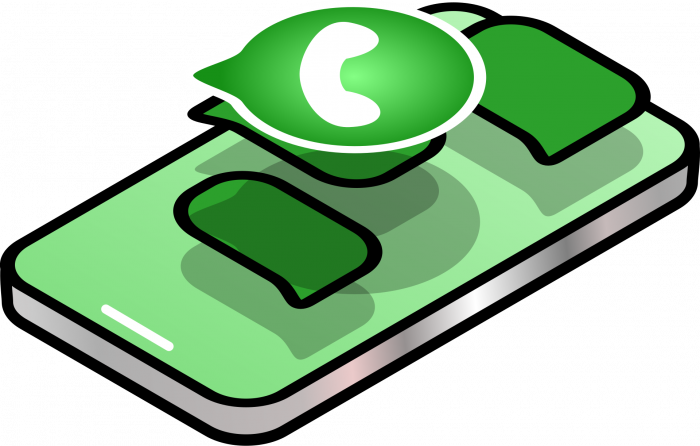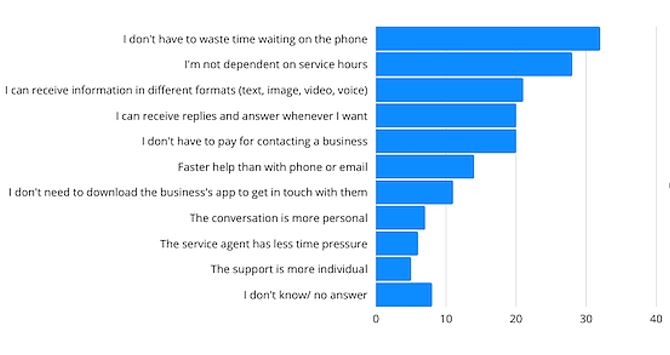
I’ve used Twitter and FB Messenger as a quick way to connect with companies whenever I have needed to, but over the last 2 weeks, I’ve used WhatsApp for the first time. I have found WhatsApp to be a great way to engage intuitively and conversationally and ultimately to get the issues I had resolved (first time) and also to make further enquiries. This has been achieved positive emotions — not negative ones — and without wasting my time or putting the onus on me to take action.
Furthermore, the two brands which directed me to WhatsApp, did so as part of their multi-channel engagement. It was simple, easy, and required the minimum of effort on my part; it still felt human even though I was using tech.
WhatsApp delivers 100 billion messages per day!
… that’s 4.2 billion messages per hour, 69 million per minute, and more than 1.1 million per second.
WhatsApp was founded in 2009 by Brian Acton and Jan Koum. Their goal was to provide users with an alternative to SMS text messaging. WhatsApp is present in 180 countries and 60 languages.
WhatsApp users have been increasing at the rate of half a billion every two years. It had 1 billion in 2016, 1.5 billion in 2018 and 2 billion monthly active users in 2020. According to MobileSquared, global WhatsApp users will top 3.1 billion in 2024.
WhatsApp is still growing and gaining a staggering 1 million new users every single day.

As of April 2020, WhatsApp was the 4th most downloaded app in the world.
WhatsApp isn’t just used for messaging. During the height of the COVID-19 pandemic last year, over 15 billion minutes of voice and video calls were made on WhatsApp every day.
Growing fast in the UK but not without problems
WhatsApp penetration rate grew from 67% in Q3 of 2019 to 77% for the third quarter of 2020. It was downloaded a whopping 2.34 million times in the UK in the fourth quarter of 2020 – which puts it in third place in WhatsApp downloads rankings, despite the relatively small size of the market.
In January 2020, WhatsApp issued a new privacy Policy which announced an ultimatum to accept new terms or delete the app. Many believed at the time, that WhatsApp would be sharing their confidential and personal data with its parent company, Facebook. These policy changes were reportedly “not well executed” and according to the UK Watchdog “Millions Stopped Using WhatsApp” as a result.
However, WhatsApp continues to rank as the most popular messaging app in the UK, with 81% of the total, according to Statista.
The total number of monthly active WhatsApp users in the UK as of 2021 is 30.1 million, which is out of a total of 62 million internet users in the UK. Based solely on the total number of WhatsApp users, it surpasses all other well-established social media platforms and messenger apps like Instagram, Facebook, and Twitter.
More and more businesses are choosing WhatsApp Business
As per the latest WhatsApp statistics available, more than 5 million businesses are actively connecting with customers on WhatsApp. These figures are from 2019 (just a year after launch) and this has inevitably grown significantly. 80% of those users believe that it helps their business grow.
Growth predictions for WhatsApp Business API are strong over the next couple of years according to Mobilesquared. Their figures forecast 5,400% growth in the number of enterprises using WhatsApp Business APIs by 2024, with almost 55,000 medium & large businesses using WhatsApp Business APIs with a total spend of $3.6 billion.
Not only are the numbers of businesses using WhatsApp set to rise, but customers are also receptive and likely to engage. Only 10% had contacted a business over WhatsApp before and in a YouGov study , 20% of users said that WhatsApp and chats with businesses were long overdue and that it should be standard for customer service. Finally, according to Ez Texting 90% of marketing text messages are read within three minutes, compared to just 20% of emails.
Delivering a better experience and reducing costs with WhatsApp
WhatsApp presents a great opportunity for businesses. Not only does it offer huge customer reach and direct engagement, but it is an “easy to adopt technology” with support for rich conversations and engagement with customers (images, videos, QR codes, etc.), and the possibility of initiating a call to action within the message itself. It is also optimised across devices – mobile, browser and desktop.
The WhatsApp Business API’s pricing model encourages businesses to reply within 24 hours as only replies in that time frame are free of charge. This means a faster response and better experience for customers, and a free means to engage with customers and deal with a whole host of topics.
As an asynchronous channel, WhatsApp Business allows customer service agents to handle more conversations simultaneously.
WhatsApp business stories
Examples of how early adopters are using WhatsApp to engage directly in conversations and build relationships with their customers:
KLM has been using WhatsApp for customer service – passengers can receive their flight information and notifications on WhatsApp.
The Financial Times, a subscriber-only publication, shares Free Content by posting two free daily articles in its WhatsApp Group. According to Digiday, they were able to get real insight into what topics are important to their potential subscribers. Those using WhatsApp were 40% more likely to return to the site within three days than those who clicked their links on other channels.
The automotive industry has been quick to embrace WhatsApp in its digital experience strategies.
- BMW uses it to manage its after-sales workshop customer service whereby customers can conveniently request the repair status of their vehicle and further information via WhatsApp. It processes 3,800 customer messages per month via the platform. It says that its call request dropped by nearly 60% and their recommendation rate through this customer touch point has intouchpoint90%.
- Skoda India is also using WhatsApp to streamline its after-sales vehicle service booking process, provide breakdown support, share COVID-19 initiatives, and share product information.
- Likewise, Hyundai India wanted to streamline the vehicle service booking process, provide service updates and documentation all in one place via their customers’ preferred communication channel.
WhatsApp offers customers more than just convenience
WhatsApp is an accessible and convenient way for consumers to get in contact with a brand without the need to download any new apps.
Back to where I started – with my own experiences. One was with Massimo Dutti. I’d placed an order via their website. When the order arrived, an item was missing, and I also wanted to return one of the delivered items. I easily returned the unwanted item to the store. For the missing item, I saw on the website that I could contact Massimo Dutti via WhatsApp. So, I did this. I quickly explained the situation and, less than 10 minutes later, they arranged for the missing item to be delivered separately. In this case, this is where the experience broke down as the missing item didn’t arrive, so the processes linked to WhatsApp were not working in this particular case, however, I did receive a phone call from Spain a week later to check if everything had been okay with the missing item (so it had been logged and actioned somewhere) and that person was able to quickly process a refund for the missing item.
I probably spent 15 minutes in total to sort this out. I can compare that to other experiences using hotlines, emails, and webchats that have taken a lot longer and often left me feeling a degree of frustration. Unlike writing an email or calling a hotline, reaching out to a business on WhatsApp feels convenient and more aligned with our texting habits.
How did I feel as a customer? Empowered. In control. Relieved that I could connect directly. Things were dealt with in real-time. The companies engaged with me as a human being, and it was both personal and personalised. And the best thing? There was no waiting in line to talk to someone and no waiting for a response that I have found to be an issue with other touchpoints and communication or service channels. It was altogether a better customer experience despite not getting the item that I’d originally wanted.
Other customers benefits are:
- It’s always ‘on’
- It doesn’t need much data – like Instagram, YouTube.
- It feels less formal, friendly, comfortable vs other channels as we normally use it with friends & family
- Given the first 24 hours are free for businesses, it’s generally faster compared to email and other channels
- WhatsApp is ‘opt in’ so consumers must permit the brand to message them.
- There are no costs to customers, unlike some hotlines.
A YouGov study dovetails into my own experience.

How to best use WhatsApp to improve and/or elevate the customer experience?
WhatsApp is clearly a useful and cost-effective technology for engaging with customers and can be a complementary and responsive channel.
There are some obvious and beneficial ways in which it can be employed in businesses:
- To handle common customer queries
- To procure & to collect customer feedback
- To send status updates and keep customers informed (this kind of visibility and transparency is probably one of the most common pain points I see)
- To share notifications real-time
- To promote and educate about products and services
- To schedule appointments and to manage bookings
- To deliver customer communication at scale
- To create communities of customers
Nonetheless, WhatsApp shouldn’t be viewed in isolation, as a tech bolt-on that sits solely within the digital space or experience. WhatsApp can span (siloed) touchpoints to manage the end-to-end customer journeys or lifecycle. My advice – map the omnichannel end to end customer journey and look at the role that WhatsApp can play across the journey, alongside all other touch points.
Explore WhatsApp through these questions (or ‘lenses’):
- What do customers value most in the current experience?
- Where are the current pain points and frustrations?
- Where are the biggest expectation gaps?
- Which stages have the biggest gaps?
- Which channels and touch points could most benefit from WhatsApp?
- Where are there simple or repetitive tasks that could easily be replaced by WhatsApp? (to free people to do more value adding tasks)
WhatsApp is efficient and convenient for both customers and businesses. If you’re still not convinced, this year, customers will spend 25% more with companies that get digital transformation right. But you must ensure digital transformation is rooted in customer journey insights and addresses all touch points as a whole. With that, we’ll see more smiling companies, happy customers.



